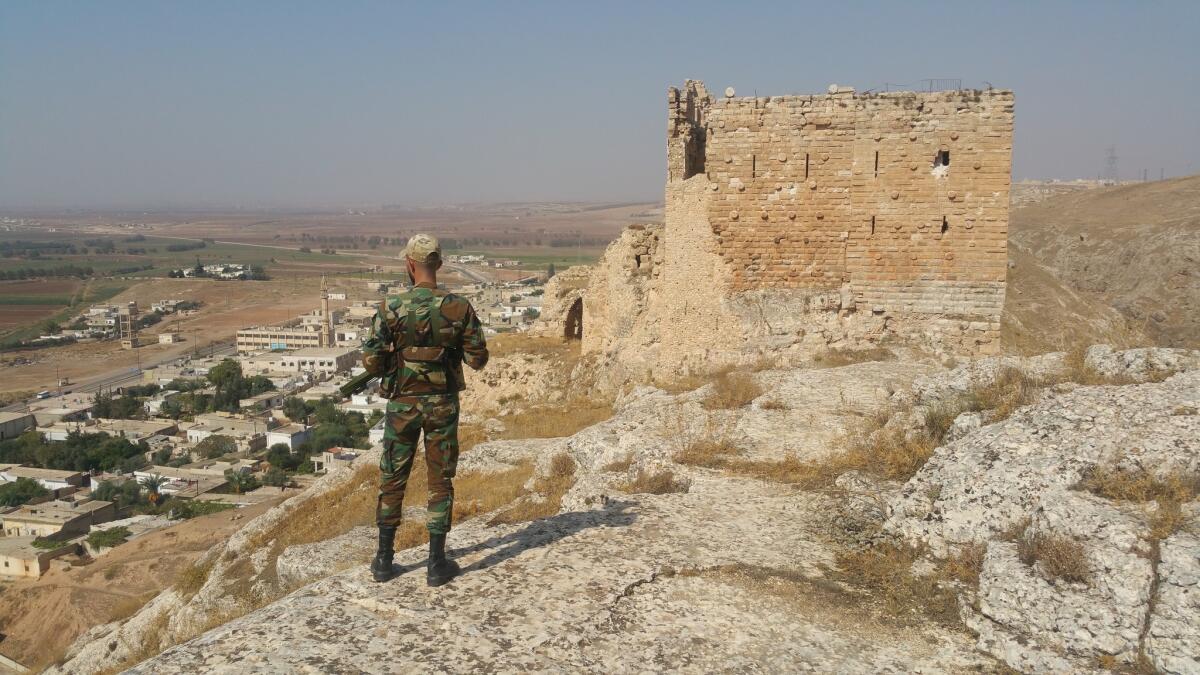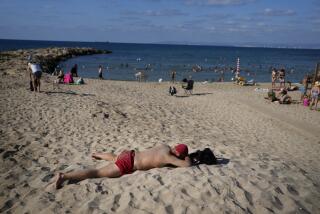With peace on the horizon in Syria, this Christian city grapples with its decision to back the government

Shadi Shahdeh, a motorcycle mechanic, was working in his shop here when he heard that a missile had struck his neighborhood along the Orontes River.
He rushed home and found his 83-year-old mother dead, slumped in the doorway. Gone too was his 8-year-old daughter, her stomach torn open by shrapnel.
A few yards up the street were the mangled remains of the rest: his 33-year-old wife and their 6-year-old son and 2-year-old daughter.
“This missile got them all,” said Shahdeh, 42. “They were shredded.”
The attack on the city, which supports Syrian President Bashar Assad in the country’s civil war, came the same day the government and its ally Russia agreed to postpone an offensive to crush what remained of the various rebel groups that had been fighting to topple him for seven years.
The rebels were confined to the neighboring province of Idlib, the final redoubt of the opposition. The attack, which killed 13 people, was a parting shot.
Weeks later, in mid-October, house gates were still adorned with pictures of the dead and the walls spotted with blood.
Only reluctantly had Mhardeh, a predominantly Christian city of 23,000 people, sided with the government in the war. But it was a choice that put the once-sleepy suburban city on the front lines and isolated it from its neighbors — predominantly Sunni Muslims, who make up the majority in Syria.
Now, as the prospects of peace in the country improve, residents here are grappling with how they can again share a future with those who had become enemies on the battlefield.
Before the war, many residents of Mhardeh worked in the provincial capital, Hama, enjoying easy friendships and professional relationships with Sunnis.
Those connections came into play when the uprisings calling for Assad’s ouster spread across Syria in 2011.
Protesters reached out to minority communities, including religious ones, in the hope of building a broad coalition against the government, said Maen Bitar, the pastor of Mhardeh’s Presbyterian church.
“They wanted to lure the Christian community to their protests. They went to the Ismailis, they tried to include the Alawites,” Bitar recalled.
He and Simon Wakil, a contractor and fellow Christian who had often employed Sunni workers, went to meet protest leaders.
“We tried to tell them, ‘Be careful, don’t be hasty….’ You cannot fight the army,” said Bitar, who refused to join the demonstrations because the activists did not tell him what reforms they espoused.
Meanwhile, the protesters, who had already clashed with security personnel and were facing a crackdown, needed access to Mhardeh: The city was the nexus of two major highways linking Hama to Syria’s coastal areas. It also had good hospitals and shops, and an electricity substation.
Bitar didn’t refuse the activists access, but he insisted they should remain peaceful.
“I said ‘I’m with you but don’t carry weapons,’” he recalled. “They confirmed that there was no intent to carry arms.”
But that soon changed.
Who bore responsibility for the violent turn has been the subject of bitter debate: The government and its supporters insist the uprising was armed from the beginning as part of a conspiratorial plot by Syria’s enemies.
The opposition says it armed itself only to repel a savage crackdown by a government that didn’t hesitate to kill its own citizens.
In any case, as more guns crept into the uprising, peaceful protests became street battles.
Residents said men with Kalashnikovs robbed a bank in the city, attacked policemen, vandalized shops and carried out kidnappings for ransom. Security personnel, fearing a large attack by armed protesters, handed their weapons to residents and fled their barracks.
In response, Wakil and others created all-volunteer armed neighborhood watch groups known as popular committees to run checkpoints at city entrances and stop the nascent opposition from entering.
Not all residents of Mhardeh agreed with the decision to take a stand against the protesters and the surrounding Sunni communities that backed them.
“Some people said we shouldn’t go against our neighbors,” Bitar said. “Others said the state would fall and we don’t want to antagonize the other side.”
But as violence escalated and Islamist groups such as the Al Qaeda-affiliated Al Nusra Front gained power, the revolution came to be seen here not as a movement to liberate Syria from Assad’s harsh rule but as a violent, Islamist plan to destroy the country and subjugate its different minorities.
Residents sided with the government because they believed the alternative was worse.
In 2012, when the army turned to the popular committees to bolster its exhausted troops and use Mhardeh as a base of operations, Wakil and others quickly agreed. He became commander of the Mhardeh Defense Force, an auxiliary grouping of about 200 fighters.
Bitar said that feelings hardened against the rebels, and eventually most people shared his view that “the men of Mhardeh should be baptized in blood.”
They were. Over the last seven years,19 members of his force were killed, along with 96 civilians, as thousands of rebel mortar attacks rained down on the city. Wakil was wounded nine times and survived a car bomb assassination attempt.
Mhardeh, meanwhile, became part of a defensive line fighting against rebels who were becoming increasingly radicalized, vowing to knock the crosses off the city’s four churches, expel its Christians and create an Islamic government in Syria.
Today, the city bears the scars of the fight.
Wakil weaves through the streets in his pickup pointing out craters from rockets or mortar shells.
But Mhardeh — unlike Aleppo, Ghouta, Dara and other opposition enclaves — never fell under rebel control.
Which meant that when Russia entered the war in 2015 and began helping the Syrian government take back those cities, Mhardeh was already on the winning side.
Across Syria, militants who refused to surrender were given safe passage to Idlib, where Al Qaeda-affiliated jihadis held sway, along with Islamist factions backed by Turkey and, to a lesser extent, the West.
With preparations underway for a government charge into Idlib, the United Nations and world powers moved to avoid what they said would be “a bloodbath” and brokered an agreement in which the government put its offensive on hold and the rebels disarmed and retreated behind a so-called de-confliction line.
The hope is that the agreement can serve as a prelude to a more comprehensive peace plan.
Mhardeh is now calm, with families coming out in their Sunday finery to attend church. At night, cafes and other hangout spots are packed.
There are occasional explosions in the distance, but nobody pays them much attention.
The September agreement theoretically meant the job of the Mhardeh Defense Force was over.
But Wakil’s cadres still man cannons near Shaizar castle, an ancient fortress built on a mountaintop at Mhardeh’s northern tip. They intend to remain active until the rebels in Idlib surrender.
But what then? Would Wakil demobilize and become a contractor once again? Could he restore relationships with residents of neighboring towns he had fought in battle?
“The soldier goes home, but we stay,” he said. “I can’t go back to civilian life.”
He said he was willing to forgive but worried that the other side would always “see me as a killer.”
“There was blood,” he said. “That means there will be vengeance.”
Twitter: @nabihbulos
More to Read
Sign up for Essential California
The most important California stories and recommendations in your inbox every morning.
You may occasionally receive promotional content from the Los Angeles Times.










